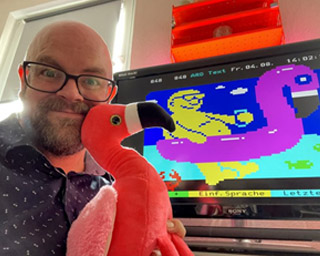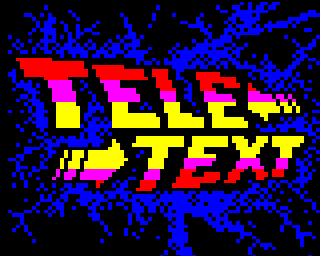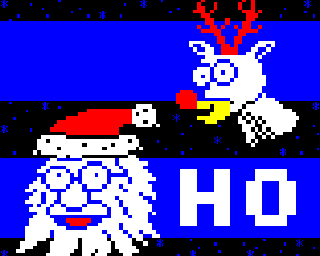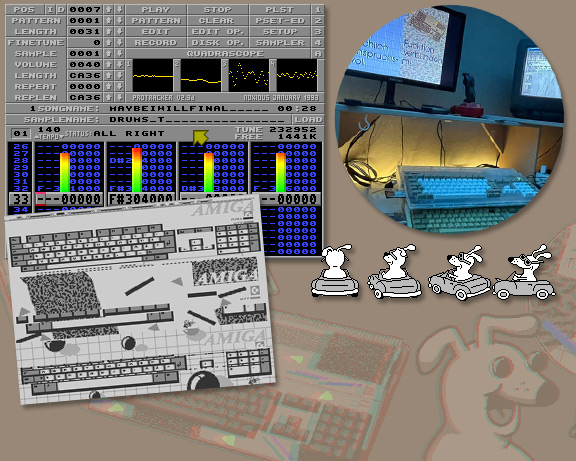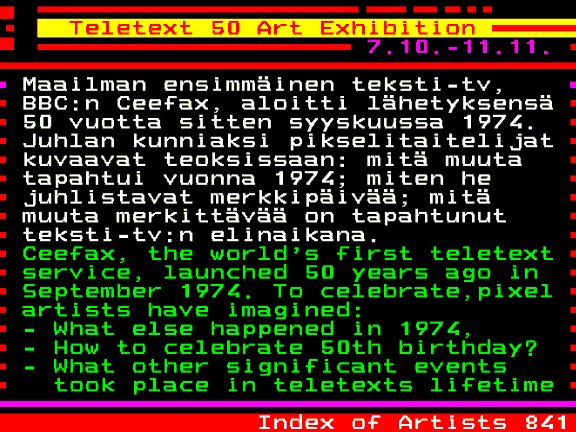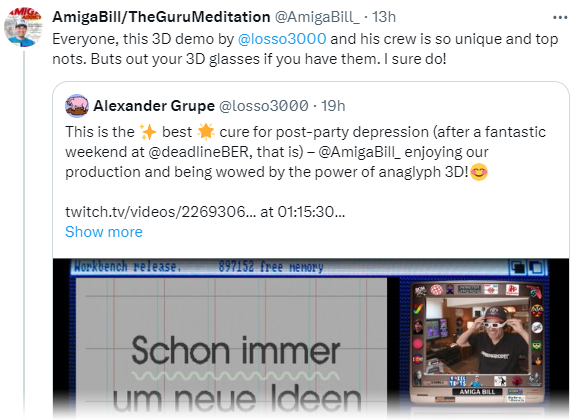There’s a final version and a lengthy write-up for our latest 3D demo now:
- new-art-final.zip
- Runs in a loop
- Fixes problems for specific disk drives and faster Amigas
- HD version (one-filer) included
- new art (the page)
- Technical background of all the things
- Pretty pictures
Reading time: 20 minutes – if you’re into oldschool tech-tech :)
On Hoffman’s recent hacking stream he was running Rink a dink REDUX and it ran into a crash, presumably because of a bad disk. Curious, I’ve triggered a crash myself by disabling fast-ram halfway through the demo:

I really dig the level of detail that went into this. Even the dead-end crash screen that nobody would ever see under normal conditions has a stylish design! There are nice background colors for different error conditions, the sound is properly muted and all sprites are reset:
; Disassembled from $c00ca4
; Color 0 move in crash copperlist:
; 000033f8: 0180 0xxx
CRASH_COLOR0 = $33fa
deadend_red:
move.w #$0804,CRASH_COLOR0
bra.b deadend_screen
deadend_green:
move.w #$0084,CRASH_COLOR0
bra.b deadend_screen
deadend_blue_or_override:
move.w #$0048,CRASH_COLOR0
move.w override_color(pc),d0
beq.b deadend_screen
move.w d0,CRASH_COLOR0
deadend_screen:
moveq #0,d0
move.w #$7fff,d1
lea $dff000,a6
move.w d1,dmacon(a6)
move.w d1,intena(a6)
move.w d1,intreq(a6)
move.w d1,adkcon(a6)
moveq #4-1,d2
lea aud0vol(a6),a0
.mute move.w d0,(a0)
lea $10(a0),a0
dbf d2,.mute
moveq #8-1,d2
lea spr0data(a6),a0
.sprdat move.l d0,(a0)
addq #8,a0
dbf d2,.sprdat
move.l #deadend_copper,cop1lc(a6)
move.w d0,copjmp1(a6)
move.w #$83c0,dmacon(a6)
.loop bra.b .loop
override_color:
dc.w 0
Of course this attitude extends to the whole production, the details, the style, the pixel-perfect transitions… I extend a very belated hats-off to Paradroid! :)
PS: “But the colors are just red, green and blue?” No! Other coders would have used, well, coder colors, but
these have style! Compare:
RGB vs the colors used here:
RGB
Finnish TV station Yle shows a Teletext exhibition celebrating the 50th Teletext anniversary. Check it out on your TV (if in Finland) or on their Teksi-TV website starting at page 840. It’s a vast showcase of amazing, clever, glitchy, cute and experimental Teletext art, so take your time to explore it all!
I’m very glad I could take part in this exhibition with my Golf and Musique Non Stop pieces! (Page 846)
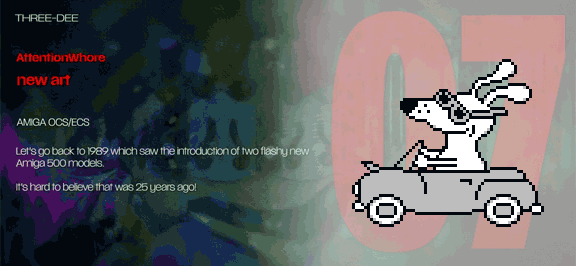
In other news, I’m also extremely glad I’ve won the 3D competition at the Deadline demoparty last weekend. I’m still busy with preparing a little write-up, but in the mean time you may check out the live recording on YouTube.
Or, even better, check out AmigaBill checking out our demo, and see the magic of angaglyph 3D in action! :)
A piece I made for the 50 years of Teletext art exhibition to be aired on Finnish station Yle TV.
1974 marks the birth of a very British invention (Teletext) and a very German invention, too… :)
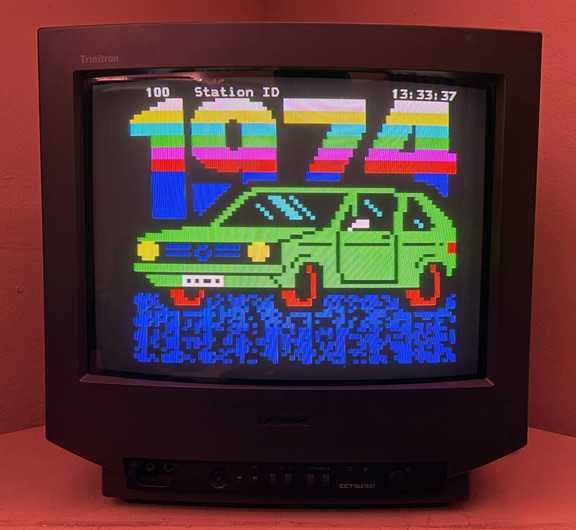
Source code as editor link.
Schon vor ein paar Wochen sind neue Rechtschreibregeln rausgekommen, und ich hab’s gar nicht mitbekommen! Das hätte ich mir als rechtschreibfixierter Jungspund nicht träumen lassen.
Nach der Grundschule erfüllte mich noch kindischer Stolz, in allen Diktaten insgesamt nur soundsoviel Fehler gemacht zu haben, und 1996 habe ich den neuen Duden verschlungen, sobald ich ihn in die Finger bekam. Neue Regeln, geil! Für mich war das der heiße Scheiß. Die Doppel-S-Regelung, mutig! „Kennen lernen“, Wahnsinn!
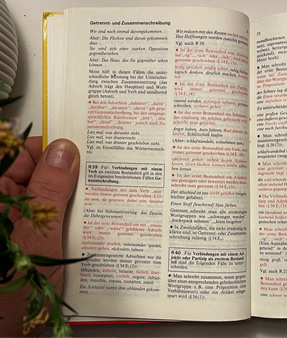
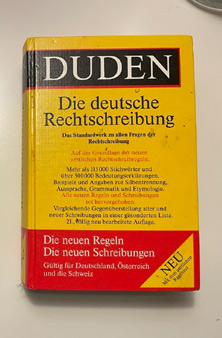
Heute? Die Zeiten sind vorbei, ohne nachzudenken die korrekte Schreibweise zu wissen und recht zu haben. Alles mögliche, pardon!, alles Mögliche muss ich nachschlagen – inklusive „recht haben“ eben gerade. Aha: In grauer Vorzeit gab es nur „recht haben“, dann war ausschließlich „Recht haben“ korrekt, irgendwann war „recht haben“ wieder im Game und jetzt ist das die empfohlene Schreibweise. Bei den alten Regeln musste man auch ein paar Merkwürdigkeiten auswendig können, aber wenigstens waren die überschaubar und eindeutig.
Oder „auswändig“ können? Nein, Quatsch, das galt ja nur von 1996 bis zweitausend-leckmichamarsch…

Jetzt ist also „gefaked“ offiziell erlaubt, wenn auch mit der schönen Einschränkung, dass es in flektierten Formen natürlich „gefakt“ heißen muss – gefakte Schlagzeilen, gefakter als du usw.
Daran werden sich bestimmt alle halten. Für 2030 sage ich voraus:
| Präsens | Präteritum | Konjunktiv I | Konju… | |
|---|---|---|---|---|
| 1. Pers. Sg. | ich fake | ich fakede | Okay, | |
| 2. Pers. Sg. | du fakesed | du fakedesed | langt | |
| 3. Pers. Sg. | sie faked | sie fakede | ||
| 1. Pers. Pl. | ich fake | wir fakeden | ||
| 2. Pers. Pl. | ihr faked | ihr fakeded | ||
| 3. Pers. Pl. | sie faken | sie fakeden |
Vielleicht kristallisiert sich mit der Zeit ja noch eine elegantere Lösung heraus? Ich wäre für die Isolierung des Fremdwortteils durch Kopplungen: ich fake-e, du fake-st, ge-fake-t!
Blog
- Oct 2024 – 3
- Sep 2024 – 6
- Aug 2024 – 5
- Jul 2024 – 6
- Jun 2024 – 6
- May 2024 – 7
- Apr 2024 – 8
- Mar 2024 – 4
- Feb 2024 – 9
- Jan 2024 – 10
- Dec 2023 – 8
- Nov 2023 – 1
- Oct 2023 – 5
- Sep 2023 – 5
- Aug 2023 – 8
- Jul 2023 – 1
- Apr 2023 – 1
Recently updated pages
- new art
- hrrngh!
- Knob-Out
- B.S.I. – Byte Scene Investigation
- Coppenheimer
- Hold mode minutiae
- Shall we play a game?
- Worms VBI
- strss
- Modding the Amiga boot hand
